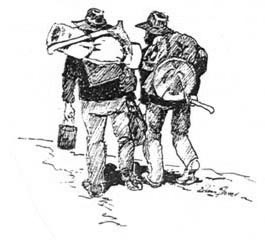


| The
earliest recorded discovery of gold was made in 1823 at Bathurst, NSW
by a Lands Department surveyor, James McBrien. McBrien was engaged in
the survey of a road along the Fish River, between Rydal and Bathurst
and at one point of the survey recorded in his field book the following
note: "At E. (end of survey line) 1 chain 50 links to river and marked
gum tree. At this point I found numerous particles of gold convenient
to river" Following this report numerous gold discoveries were made in New South Wales but these were hushed up by a government fearful of the consequences it would have on the pastoral industry if workers left for the goldfields. It was not until Edward Hammond Hargaves discovery of payable gold in 1851 that any real gold rush began in Australia. Gold was found in Victoria in 1851, Queensland in 1858, Tasmania in 1886 and in Western Australia in 1886 |
|
Discovery Of Gold At Pleasant Creek, Stawell
William McLachlan discovered gold at Pleasant Creek in May 1853 while fossicking in Pleasant Creek in his spare time found some gold. It only was a small amount of gold - some pennyweights - and although the find was made known, not many people came here then. This was then a very isolated area, water was scarce and there were no supplies of food while the goldfields of Ballarat, Bendigo, Clunes etc. were operating with stores already established. Some people did come and there were also people passing through here from South Australia to the Victorian goldfields who stopped and washed small quantities of gold. Apparently some gold diggers came and went during the next four years - finding some small quantities - and in August 1857 - the big rush occurred at what became known as Commercial Street, Pleasant Creek - off the Halls Gap Road. This rush spread across to Deep Lead and the Warden reported at the height of the rush, said that there were 25,000 to 30,000 people there. At the same time, shafts were being sunk around Big Hill and gold was found in the quartz there. The Big Hill area was called Quartz Reefs, Pleasant Creek. Much alluvial gold was found in the Illawarra/Deep Lead area but how much and who found it is not known. The diggers took their gold and left and the field had petered out by 1859 - only lasting less then two years with a very diminishing numbers of diggers. The Quartz Reefs became a stable gold field and companys were formed to purchase the machinery needed and employed many miners. This goldfield was known as "Stawell's Golden Mile" although it extended for a mile and a half or more from the Wonga - along the foot of Big Hill - down Newington Road out to the Three Jacks. Huge amounts of gold were found and fortunes made. Of the 14 richest mines in Victoria. Number 8 on that list was the Cross Reef at Stawell and number 10 was the Magdala at Stawell. Mining here slowed down in the late 1880's with many mines closing from then to the 1890's and the last mine closed in 1920. Mining resumed in Stawell in 1982 and gold is still being found underground today. |